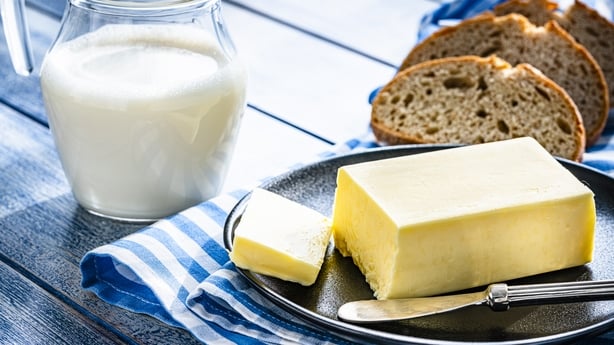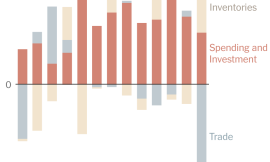Figures from the Central Statistics Office show the Consumer Price Index – that’s overall change in the prices of goods – rose 1.8% between February of this year and last year.
And a recent study by research company Kantar showed that grocery costs have increased by 3% in the past year.
With this in mind, Cian McCormack took his shopping list from 2021 and compared what he paid for it then to what it costs today.
One thing is clear from the experiment: groceries cost much more than they did four years ago.
My own shopping basket saw a 36% increase.
My methodology was simple for the exercise. I took receipts from 2021 and did the same shopping again this week.
What I found was the same basket was €18.03 more expensive – a 36% increase in what I paid four years ago.
My trolley of goods cost €53.70 in 2021. This week it cost €71.73 for the same items.
The biggest increase in my shopping basket was the humble red pepper. Items like this can be impacted by seasonal availability and supply.
They have increased from 39 cent to 89 cent – that’s a 128% increase.
The prices of staples like bread, butter, eggs and milk have all gone through the roof too since 2021.
The price of 454 grammes of butter, what would be referred to as a pound of butter, was €2.19 in 2021 and this year it rose to €3.79. The increase of €1.60 means there is a 70% increase in price.
Two litres of whole milk increased from €1.49 to €2.45. That jump of 96c means that amount of milk is 64% dearer for consumers.
A sliced pan from a local convenience store increased from €2.40 to €3.40, and six free-range eggs in my supermarket shopping trolley went from €1.99 to €2.25 – an increase of around 12%.

The biggest shock for me was the prices of some of vegetables.
A cauliflower cost €1.29 four years ago. It’s now €1.79 – a 40% increase in price. Spuds, 2kgs of roosters, cost €2.49 in 2021, they are now €3.79 – an increase of €1.30 or 52%.
Then in terms of protein, chicken and salmon had price increases too. A medium-sized chicken was 19% dearer – rising in cost to €4.99 from €4.19.
A packet of four salmon darnes was 50% more expensive, jumping from €5 to €7.49.
Putting the ingredients together to cook a Sunday dinner for four people shows the real impact on the dinner plate.
A dinner consisting of a medium chicken, potatoes, carrots and cauliflower were purchased for €8.46 in 2021. That same dinner costs €11.16 today, representing an increase of €2.70 or 32%.
The reasons for increases are many and include: global supply chain issues, logistic costs, world events, energy costs, labour costs, and inflation.
Lecturer in retail management at TU Dublin Damian O’Reilly said prices won’t be coming down and people need to understand this reality.
Speaking on RTÉ’s Morning Ireland programme, he said: “It’s not good for the average consumer.”
We need your consent to load this rte-player contentWe use rte-player to manage extra content that can set cookies on your device and collect data about your activity. Please review their details and accept them to load the content.Manage Preferences
He added that the increases are down to a number of factors. Giving examples, Mr O’Reilly said that for bread “input costs went up for wheat with the Ukraine war”.
Labour costs have also increased, he said.
“They have gone up significantly” and “companies are having to self-enroll for pensions as well”, he said.
The retail lecturer said the 36% rise in my shopping trolley represented the rise in grocery costs people have seen in Ireland over the past four years.
“Prices have seemed to have plateaued and stabilised. But, we have got to learn that the jump and shock [in prices] we had in 2021 and 2022 [with inflation] – that huge increase that we had in prices is not coming down.”
Retail Ireland – which represents shops – said Irish prices increased in Ireland by less that the EU average of 33% since February 2021. It said retailers are aware of the pressures on household budgets.
Arnold Dillon, Director of Retail Ireland, said: “A dramatic increase in costs across the supply chain pushed up grocery prices right across Europe over recent years. This included sharp rises in commodity prices, along with energy and labour costs.
“Irish prices have, however, increased by less than the EU average of 33% since February 2021, and inflation has eased dramatically since it peaked in 2022.
“In June 2023 the Competition and Consumer Protection Commission published a report which looked at competition in the Irish grocery sector. It found no evidence of market failure, anti-competitive practices or excessive pricing in the Irish market.
“Irish retailers are acutely aware of the pressure on household budgets and are committed to delivering value for consumers. Specific pricing decisions are a matter for individual retailers, but consumers benefit from intense competition in the sector.
“Retailers have also broadened their range of own brand and value products to provide lower cost alternatives and more choice to consumers,” said Mr Dillon.

The rising cost of the weekly shop is a bitter pill to swallow for people I talked to in Dublin yesterday.
One mother of two children under the age of two told me she sometimes goes without food because she needs to feed her children first.
“It’s quite ridiculous actually,” said the woman about the cost of groceries.
“It’s not fair on people that can’t really afford a lot with the bills going up – like say electric and everything else going up as well as food.
“I have the same amount of money but I have less to spend on food,” she said.
She added she sometimes “can’t afford” items for herself and would feed her children and “skip meals” or “have less” herself.
Other people I talked to about the cost of their weekly shop said they felt they “are bring ripped off” and that while consumers need to shop around, the Government needs to address the issue.
One retired woman said her pension might rise “every now [and then]” but it does not “keep up with inflation”.
Punters concerns are echoed by Saint Vincent De Paul. The charity said people contact them when they can’t put food on the table.
Louise Bayliss, Head of Social Justice and Policy, said she was not surprised to see the 36% increase in my shopping trolley.
That increase is reflected by the numbers of people contacting the charity looking for vouchers for food, she said.
“They really only contact us when it gets down to food. Sometimes when they contact us they are saying, ‘would you have a voucher for food’.”
She said normal, everyday foods are going up and this impacts on “all types of households”.
“Bread has gone up. Milk has gone up. Those real essentials that families can’t avoid. You’re paying more for it and it is impacting on all types of households,” said Ms Bayliss.
She added there is a deep concern that people will struggle to feed their families.
“We are very concerned because we’re coming out of winter, there’s 440,000 households who are in arrears with utility bills. We’ve been told that there will not be energy credits this year.
“We want to make sure those families, who are already in utility arrears, are protected if we see more price increases.
“If something like energy goes up that impacts on people’s budgets in so many ways. We are concerned that people will be struggling to feed their families,” she added.




